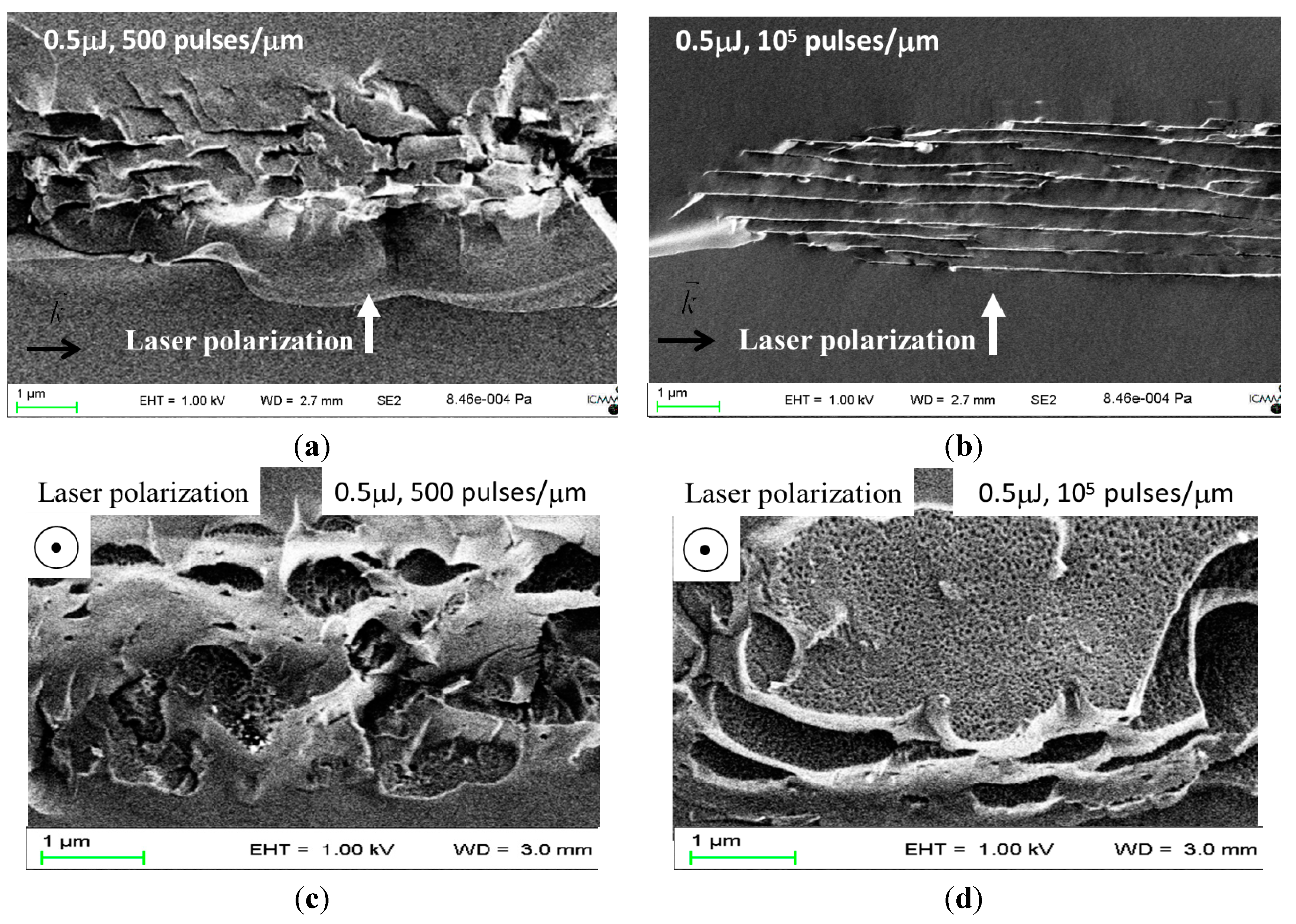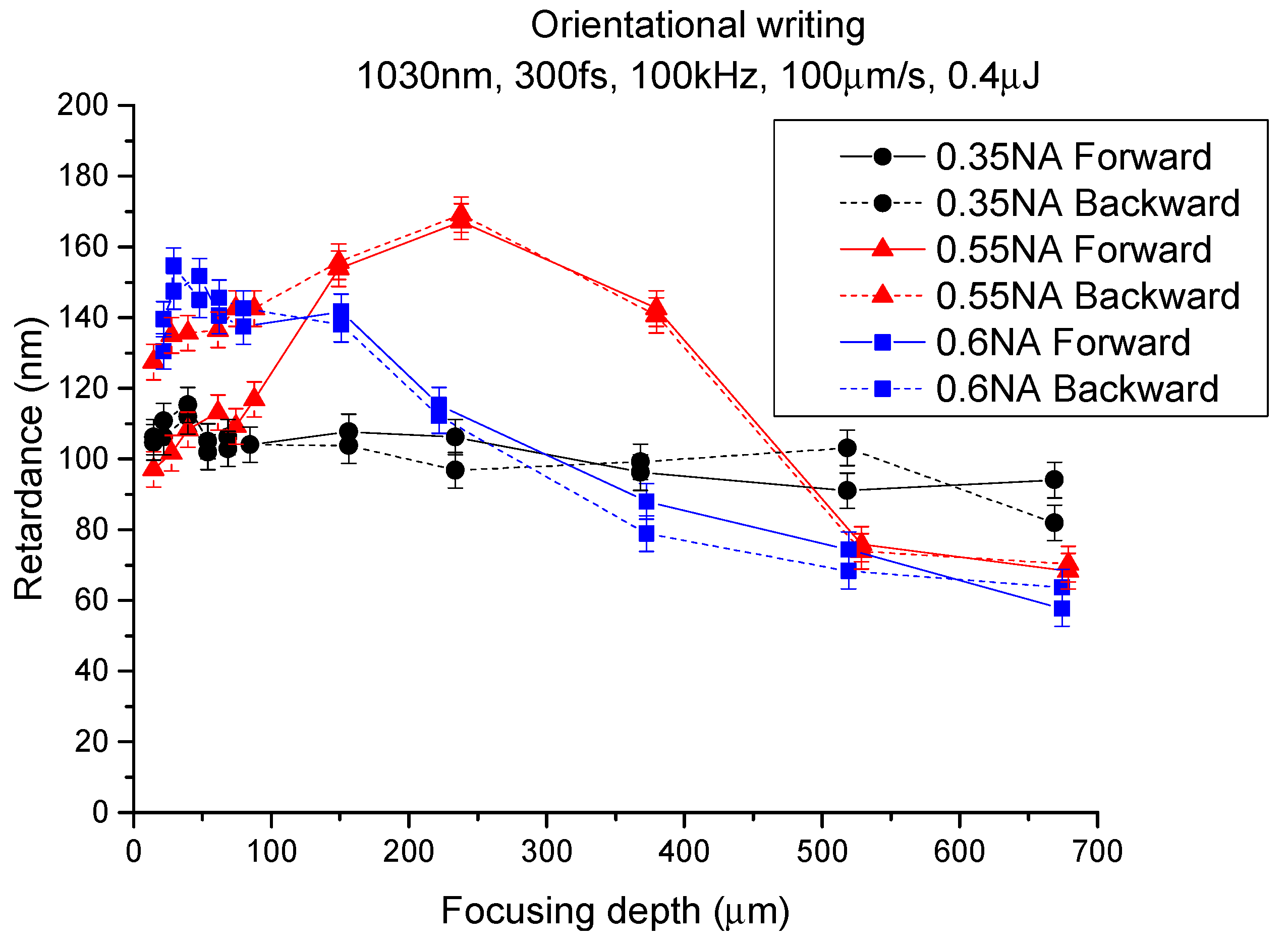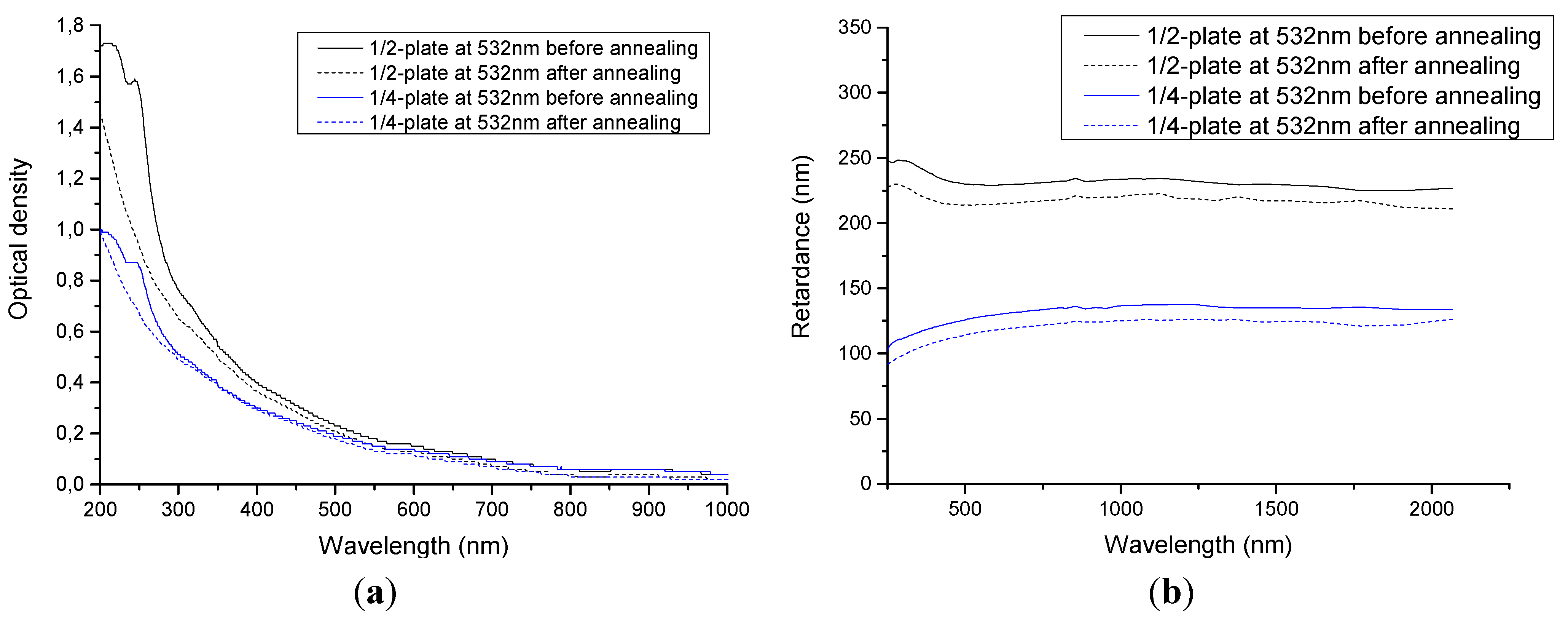Compact Birefringent Waveplates Photo-Induced in Silica by Femtosecond Laser
Abstract
:1. Introduction
2. Experimental Section
3. Results and Discussion
3.1. Minimizing Diffraction and Light Scattering

3.2. Minimizing the Orientational Writing Effect

3.3. Minimizing the Focusing Depth Dependence in Order to Write Multilayer Waveplates

3.4. Stacking Birefringent Layers


3.5. Loss and Birefringence Dispersion
4. Conclusions
Acknowledgments
Author Contributions
Conflicts of Interest
References
- Itoh, K.; Watanabe, W.; Nolte, S.; Schaffer, C.B. Ultrafast processes for bulk modification of transparent materials. MRS Bull. 2006, 31, 620–625. [Google Scholar] [CrossRef]
- Kazansky, P.G.; Yang, W.; Bricchi, E.; Bovatsek, J.; Arai, A.; Shimotsuma, Y.; Miura, K.; Hirao, K. “Quill” writing with ultrashort light pulses in transparent materials. Appl. Phys. Lett. 2007, 90, 151120. [Google Scholar] [CrossRef]
- Poumellec, B.; Lancry, M.; Desmarchelier, R.; Hervé, E.; Brisset, F.; Poulin, J. Asymmetric Orientational Writing in glass with femtosecond laser irradiation. Opt. Mater. Express 2013, 3, 1586–1599. [Google Scholar] [CrossRef]
- Yang, W.; Kazansky, P.; Svirko, Y. Non-reciprocal ultrafast laser writing. Nat. Photonics 2008, 2, 99–104. [Google Scholar] [CrossRef]
- Lancry, M.; Poumellec, B.; Canning, J.; Cook, K.; Poulin, J-C; Brisset, F. Ultrafast nanoporous silica formation driven by femtosecond laser irradiation. Laser Photonics Rev. 2013, 7, 953–962. [Google Scholar]
- Canning, J.; Lancry, M.; Cook, K.; Weickman, A.; Brisset, F.; Poumellec, B. Anatomy of a femtosecond laser processed silica waveguide [Invited]. Opt. Mater. Express 2011, 1, 998–1008. [Google Scholar] [CrossRef]
- Shimotsuma, Y.; Kazansky, P.; Qiu, J.; Hirao, K. Self-organized nanogratings in glass irradiated by ultrashort light pulses. Phys. Rev. Lett. 2003, 91, 247405. [Google Scholar] [CrossRef]
- Birnbaum, M. Semiconductor Surface Damage Produced by Ruby Lasers; Aerospace Corp: EL Segundo, CA, USA, 1966. [Google Scholar]
- Bricchi, E.; Klappauf, B.G.; Kazansky, P.G. Form birefringence and negative index change created by femtosecond direct writing in transparent materials. Opt. Lett. 2004, 29, 119–121. [Google Scholar] [CrossRef]
- Champion, A.; Beresna, M.; Kazansky, P.; Bellouard, Y. Stress distribution around femtosecond laser affected zones: Effect of nanogratings orientation. Opt. Express 2013, 21, 24942–24951. [Google Scholar] [CrossRef]
- Fernandes, L.A.; Grenier, J.R.; Herman, P.R.; Aitchison, J.S.; Marques, P.V. Stress induced birefringence tuning in femtosecond laser fabricated waveguides in fused silica. Opt. Express 2012, 20, 24103–24114. [Google Scholar] [CrossRef]
- Cheng, G.; Mishchik, K.; Mauclair, C.; Audouard, E.; Stoian, R. Ultrafast laser photoinscription of polarization sensitive devices in bulk silica glass. Opt. Express 2009, 17, 9515–9525. [Google Scholar] [CrossRef]
- Zhang, J.; Geceviçius, M.; Beresna, M.; Kazansky, P.G. 5D data storage by ultrafast laser nanostructuring in glass. In Proceedings of CLEO: Science and Innovations, San Jose, CA, USA, 9–14 June 2013.
- Beresna, M.; Geceviçius, M.; Kazansky, P.G. Polarization sensitive elements fabricated by femtosecond laser nanostructuring of glass [Invited]. Opt. Mater. Express 2011, 1, 783–795. [Google Scholar] [CrossRef]
- Beresna, M.; Geceviçius, M.; Kazansky, P.G.; Gertus, T. Radially polarized optical vortex converter created by femtosecond laser nanostructuring of glass. Appl. Phys. Lett. 2011, 98, 201101. [Google Scholar] [CrossRef]
- Fernandes, L.A.; Grenier, J.R.; Herman, P.R.; Aitchison, J.S.; Marques, P.V. Femtosecond laser writing of waveguide retarders in fused silica for polarization control in optical circuits. Opt. Express 2011, 19, 18294–18301. [Google Scholar] [CrossRef]
- Corrielli, G.; Crespi, A.; Geremia, R.; Ramponi, R.; Sansoni, L.; Santinelli, A.; Mataloni, P.; Sciarrino, F.; Osellame, R. Rotated waveplates in integrated waveguide optics. Nat. Commun. 2014, 5, 4249. [Google Scholar] [CrossRef]
- Zimmermann, F.; Richter, S.; Vetter, C.; Doring, S.; Tunnermann, A.; Nolte, S. Ultrashort pulse-induced nanogratings: Temperature stable optically active phase elements. In Proceedings of 2013 Conference on Lasers and Electro-Optics Europe and International Quantum Electronics Conference, Munich, Germany, 12–16 May 2013.
- Davis, K.M.; Miura, K.; Sugimoto, N.; Hirao, K. Writing waveguides in glass with a femtosecond laser. Opt. Lett. 1996, 21, 1729–1731. [Google Scholar] [CrossRef]
- Richter, S.; Jia, F.; Heinrich, M.; Döring, S.; Peschel, U.; Tünnermann, A.; Nolte, S. The role of self-trapped excitons and defects in the formation of nanogratings in fused silica. Opt. Lett. 2012, 37, 482–484. [Google Scholar] [CrossRef]
- Lancry, M.; Desmarchelier, R.; Zimmermann, F.; Guth, N.; Brisset, F.O.; Nolte, S.; Poumellec, B. Porous nanogratings and related form birefringence in silicate and germanate glasses. In Proceedings of Bragg Gratings, Photosensitivity, and Poling in Glass Waveguides, Barcelona, Spain, 27–31 July 2014.
- Corbari, C.; Champion, A.; Geceviçius, M.; Beresna, M.; Bellouard, Y.; Kazansky, P.G. Femtosecond versus picosecond laser machining of nano-gratings and micro-channels in silica glass. Opt. Lett. 2013, 21, 3946–3958. [Google Scholar]
- Geceviçius, M.; Beresna, M.; Zhang, J.; Yang, W.; Takebe, H.; Kazansky, P.G. Extraordinary anisotropy of ultrafast laser writing in glass. Opt. Lett. 2013, 21, 3959–3968. [Google Scholar]
- Hasegawa, S.; Hayasaki, Y. Holographic vector wave femtosecond laser processing. Int. J. Optomechatron. 2014, 8, 73–88. [Google Scholar] [CrossRef]
- Beresna, M.; Geceviçius, M.; Lancry, M.; Poumellec, B.; Kazansky, P. Broadband anisotropy of femtosecond laser induced nanogratings in fused silica. Appl. Phys. Lett. 2013, 103, 131903. [Google Scholar] [CrossRef]
- Jesacher, A.; Booth, M.J. Parallel direct laser writing in three dimensions with spatially dependent aberration correction. Opt. Lett. 2010, 18, 21090–21099. [Google Scholar]
- Lancry, M.; Poumellec, B.; Desmarchelier, R.; Bourguignon, B. Oriented creation of anisotropic defects by IR femtosecond laser scanning in silica. Opt. Mater. Express 2012, 2, 1809–1821. [Google Scholar] [CrossRef]
- Sun, H.B.; Juodkazis, S.; Watanabe, M.; Matsuo, S.; Misawa, H.; Nishii, J. Generation and recombination of defects in vitreous silica induced by irradiation with a near-infrared femtosecond laser. J. Phys. Chem. B 2000, 104, 3450–3455. [Google Scholar] [CrossRef]
- Lancry, M.; Groothoff, N.; Poumellec, B.; Guizard, S.; Fedorov, N.; Canning, J. Time-resolved plasma measurements in Ge-doped silica exposed to infrared femtosecond laser. Phys. Rev. B 2011, 84, 245103. [Google Scholar] [CrossRef]
- Bricchi, E.; Kazansky, P.G. Extraordinary stability of anisotropic femtosecond direct-written structures embedded in silica glass. Appl. Phys. Lett. 2006, 88, 111119. [Google Scholar] [CrossRef]
- Beresna, M. Polarization Engineering with Ultrafast Laser Writing in Transparent Media; University of Southampton: Southampton, UK, 2012. [Google Scholar]
© 2014 by the authors; licensee MDPI, Basel, Switzerland. This article is an open access article distributed under the terms and conditions of the Creative Commons Attribution license (http://creativecommons.org/licenses/by/4.0/).
Share and Cite
Lancry, M.; Desmarchelier, R.; Cook, K.; Poumellec, B.; Canning, J. Compact Birefringent Waveplates Photo-Induced in Silica by Femtosecond Laser. Micromachines 2014, 5, 825-838. https://doi.org/10.3390/mi5040825
Lancry M, Desmarchelier R, Cook K, Poumellec B, Canning J. Compact Birefringent Waveplates Photo-Induced in Silica by Femtosecond Laser. Micromachines. 2014; 5(4):825-838. https://doi.org/10.3390/mi5040825
Chicago/Turabian StyleLancry, Matthieu, Rudy Desmarchelier, Kevin Cook, Bertrand Poumellec, and John Canning. 2014. "Compact Birefringent Waveplates Photo-Induced in Silica by Femtosecond Laser" Micromachines 5, no. 4: 825-838. https://doi.org/10.3390/mi5040825
APA StyleLancry, M., Desmarchelier, R., Cook, K., Poumellec, B., & Canning, J. (2014). Compact Birefringent Waveplates Photo-Induced in Silica by Femtosecond Laser. Micromachines, 5(4), 825-838. https://doi.org/10.3390/mi5040825





